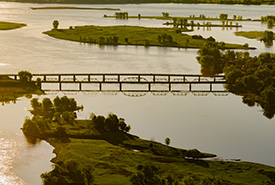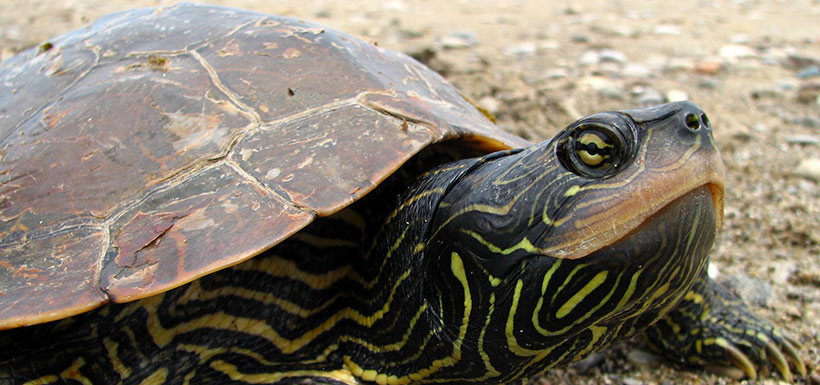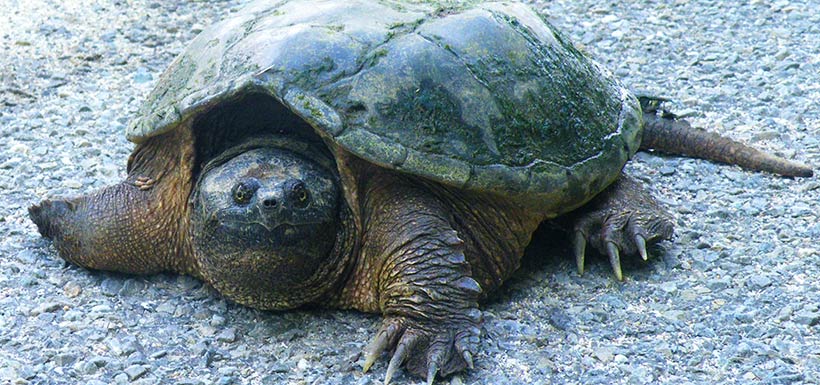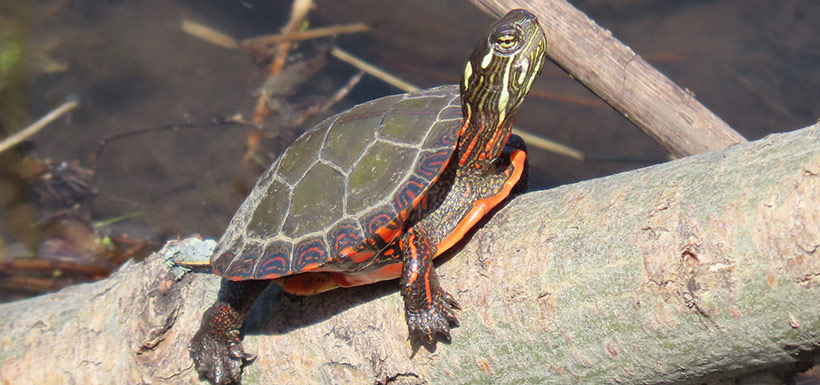Protecting the turtles of the Hochelaga Archipelago

Aerial photo of the Hochelaga Archipelago islands at dawn (Photo by Patrice Bériault)
A resilient species in a highly urbanized environment
It is easy to forget that the Montreal area is an archipelago made up of more than 300 islands and islets, as well as several waterways. In this aquatic environment, right in the heart of the greater metropolitan area, live numerous species, including map turtle, painted turtle and snapping turtle.
Map turtle
Map turtles can be identified by the yellow lines on their neck and legs. Their name comes from the lines on the carapace (upper shell), which resemble a topographic map. It might seem like there are many map turtles, particularly in the Lake of Two Mountains, but their population is in a precarious state.
Snapping turtle
Snapping turtles have long tails with prominent edges and saw blade teeth, giving them a prehistoric look. They are the largest of the three species found in the Lake of Two Mountains: This species can measure between 20 to 49 centimetres in length. They can extend their neck very quickly to bite if provoked, so watch your fingers!
Painted turtle
This species’ carapace (upper shell) is smooth, dark on the top with a yellow plastron (bottom part of the shell). These very colourful turtles have red streaks on their legs and tail.
These three species of turtle are at risk on the provincial level, federal level or both. The disappearance of these turtles and their habitat could lead to irreversible consequences in the food chain of other species that share the same habitat. Protecting turtle habitat also contributes directly to the conservation of natural shoreline habitats, good water quality and helps limit the risks of flooding.
Are you a landowner with a shoreline and would like to help protect turtles? Be inspired by these two waterfront property owners who shared their experiences with NCC:
Threats to turtle populations
While an adult turtle’s shell provides very effective protection against predators, it is of no use against habitat degradation. The loss of egg-laying and sun-basking sites, which are critical habitats for this species' survival, are the main threat turtles face.
Turtles also suffer injuries, sometimes fatal, from boat propellers or collisions with cars. It is also suspected that populations of turtle nest predators (raccoon, skunk, fox, etc.), which are artificially elevated in urban and suburban environments, limit turtle reproduction and threaten the long-term survival of populations.
What is NCC doing to protect habitat for this species?
Actions carried out by NCC cover five areas:
- protecting riparian habitats within the turtle's range through the creation of protected areas;
- acquiring knowledge on turtle distribution through the carapace.ca platform;
- developing and protecting egg-laying sites and installing basking structures in areas where such sites are inadequate or insufficient; and
- raising awareness among shorefront landowners, citizens and elected officials on the importance of conserving this species.
How to help turtles
- Never disturb, touch or move a turtle or its eggs unless the turtle is on the road.
- Avoid removing tree branches and trunks by the sides of waterbodies.
- Report your sightings of live, wounded or dead turtles on carapace.ca or the Atlas des amphibiens et des reptiles du Québec (in French only).
- Reduce motorboat speed near shorelines and in shallow bays to reduce the number of turtle collisions.
- Learn more about protecting turtle nests with this fact sheet from the Canadian Wildlife Federation.
- Do you own land that is used by turtles? Contact NCC for recommendations on what you can do to help them.
Acknowledgements
NCC would like to thank its project partners, including the Groupe de mise en œuvre du rétablissement de la tortue géographique, Ecomuseum Zoo, City of Montreal, Nature-Action Québec, Éco-Nature and St. Lawrence Action Plan (Community Interaction Program). Any citizens, private landowners, municipal employees/elected officials or organizations interested in protecting the turtles of the Hochelaga Aarchipelago are invited to contact Annie Ferland, project manager, Nature Conservancy of Canada, at annie.ferland@conservationdelanature.ca. Together, let's look after this fascinating species for future generations.













